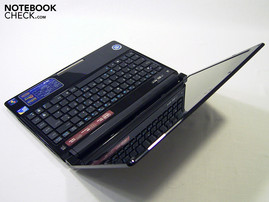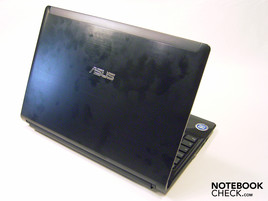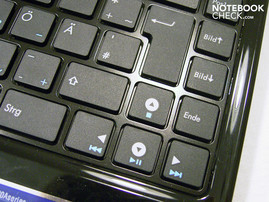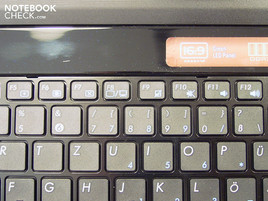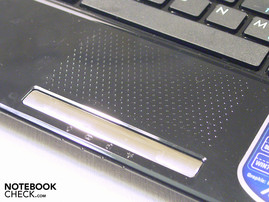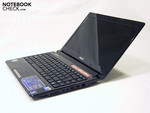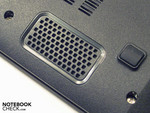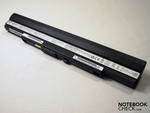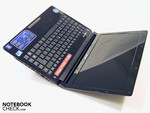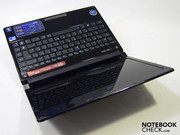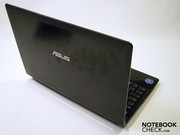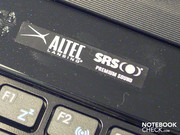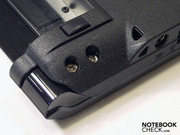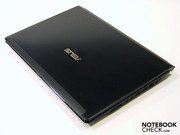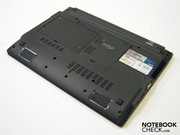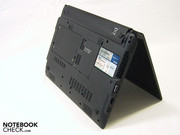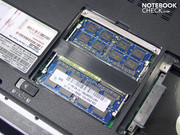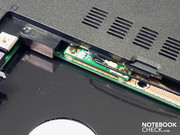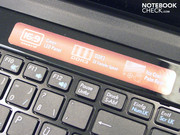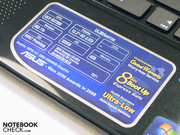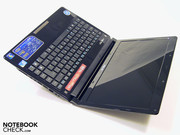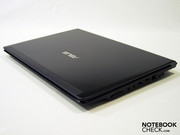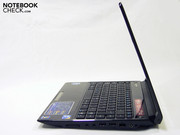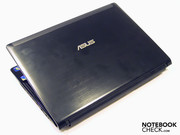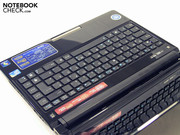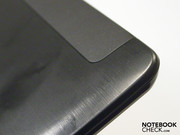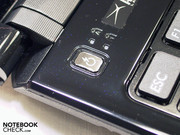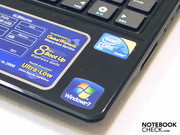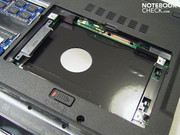Review Asus UL30A-QX050V Notebook
15-Hour marathon.
The polite big brother of the currently at hand Asus UL30A, already had to endure a comprehensive test by our editorial team. Those who opt for the handy 13.3 inch version, are looking for compact mobility. The absence of an optical drive in the UL30A is accepted as a compromise in this case. What counts is battery life, and this is provided in abundance by this laptop.
In this review the subject of focus will be the Asus UL30A, without further comparisons to the bigger brother model UX50V. This is the first time that Asus has sent our editorial team a dual core processor in the form of an Intel Core 2 Duo SU7300. This CPU belongs to Intel's CULV family, which was born in the middle of this year. These are variants of Intel's ultra-low-voltage processors, which have only recently started being offered in thin consumer notebooks. The novelty with this: thin and light notebooks with battery lives between 5 and 8 hours are no longer restricted to the premium price segment of the market. Intel CULV notebooks are available at affordable prices between 500 and 800 Euros. This also applies to the Asus UL30A, with an attractive price of 650 Euros. We will cover the advantages and disadvantages, and find out whether it is worth buying.
Case
Asus delivers a 1.8 kilogram, 13.3 inch device. The case is sufficiently stiff for the intentional mobile use, but is by no means perfect. While the palm resting area is convincingly firm, the rear part of the chassis is easily bent. The large battery, which is attached to the rear, moves noticeably when the case is warped.
The surfaces of the palm rest areas and above the keys, as well as the base plate, sit firmly and do not bend anywhere, not even when when strong pressure is applied. The lid is also sufficiently stiff, considering its thin construction. Held at the edges we were only able to bend it by a few degrees, and light pressure to the lid surface does not immediately provoke pressure points on the TFT. The two hinges, to which the display is attached, are fixed a little loosely. Nevertheless the display is still held firmly held in place in every position, and does not teeter when subjected to vibrations such as when in a train or a car.
Asus have succeeded with the brushed aluminum lid surface. It has a high quality feel to the touch, even though a little cool. Unfortunately the thin surface does create the impression of being sensitive to impacts and pressure. Such that small objects in the notebook bag, for example a ballpoint pen or USB drive, could easily cause an unrepairable dent in the surface.
Our biggest area of criticism on the case is however not the partially lacking stability, but the surface of the working area. The at first pretty high-gloss finish, quickly develops into a collection of fingerprints. This reflective surface also extends over the display frame, which can cause disturbing reflections when light sources are located in the background.
Connectivity
When it comes to the connectivity, Asus makes full use of the entire width that is made available due to the absence of an optical drive. The thin front edge is not fitted with any ports, switches or card readers. All connections are either located on the right or left edges, and the back is occupied by the battery unit. The order of their arrangement is sensible: VGA directly next to HDMI on the left side. This way no thick cables get in the way when using a right-handed mouse. Left-handed people however have to work around the HDMI and USB cables that can get in the way left of the notebook.
Card reader and audio ports are located on the right in the front area. This way a connected USB cable will only interfere with the use of a mouse in certain cases. Connections would of course, as with every other notebook, be ideally situated on the rear side, but the inclusion of a detachable battery would not have been possible in this way.
Input Devicecs
Keyboard
The keyboard is definitely suitable for people who type a lot, provided you can see out over the key-base which gives way noticeably. The detached keys also provide accuracy for people with large hands. In our opinion the end stop is too soft, and the key feedback could be more pronounced. When writing with this keyboard, we don't get the impression that we are working with something thoroughly thought out of high-quality.
Of course it could be worse. But in the end the only thing that gives this the upper hand compared to the competition is the successful layout, with the large keys and clear labeling. The blue function-keys for access to special controls, such as screen brightness, volume, mute or WLAN are clearly arranged in the middle of the F-key row. Also well designed is the power-mode button above the keyboard.
Touchpad
The touchpad is located inline with the palm resting area. So that this is actually discernible, Asus has covered the area with shallow grooves. Unfortunately our navigational prowess is not improved by the slippery and after some time smeary surface.
What cannot be omitted for the sake of completeness: A multi-touch pad (Elan Smart-Pad), which recognizes the use of two fingers simultaneously, through which it is possible to perform two-finger-gestures. With which the user can for instance zoom in and out, and scroll up or down in a word document.
Display
With a black-level of 1.09 we have calculated a maximum contrast of 168:1. A higher contrast would be favorable, is however not to be expected in this price range. Colors give a pale and faint impression, rather than crisp and fresh. The glossy display however deludes a little, and gives the colors back a bit of brilliance.
| |||||||||||||||||||||||||
Brightness Distribution: 81 %
Center on Battery: 183.5 cd/m²
Contrast: 175:1 (Black: 1.09 cd/m²)
The glossy AUO-panel (type AUO102C) could neither convince the reviewers with good contrasts nor brightness. On average we measured 183.5 cd/m². The maximum light density we measured was 206 cd/m², and this was in the upper left corner. Especially in regard to the high reflectiveness of the display, a luminance above 230 cd/m² would be favorable. In this way it is however almost impossible for stress free use under direct sunlight. When running off battery power the brightness is not decreased. A light sensor, as fitted into the 15.6 inch brother model UX50V, is not available in the UL30A.
The horizontal viewing angle is relatively good. Until approximately 45 degrees off center we can recognize writing. Only at higher angles the colors start to invert and the display quickly darkens. When looking from below, writing is legible until approximately 40 degrees. But the brightness decreases significantly after about 10 degrees. If friends gather around the Asus UL30A, then viewers from above can hardly recognize anything from a movie. Already at 40 degrees above the colors are significantly inverted. Writing is then no longer recognizable or legible, and colors are no longer discernible as such.
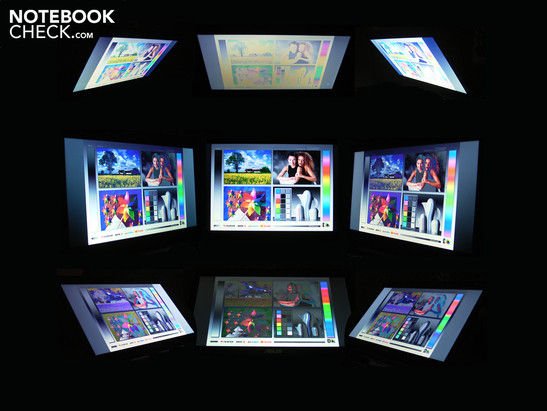
Performance
We tested the Asus UL30A with Windows 7 Home Premium, as Asus delivered it to our editorial team, with the latest Microsoft operating system.
The Intel Core 2 Duo SU7300, with its 2 x 1.3 GHz, currently belongs to the fastest CULV processors by Intel. The only one that is faster is the SU9400 (2 x 1.4 GHz), which is available in some Acer Travelmate 8471 models for example. The "SU" stands for "Mobile Small Package CPU", hence processors with a very high energy efficiency. The TDP is smaller than or equal to 11.9 Watts (Intel definition). In the case of the SU7300 the maximum Thermal Design Power (TDP) lies at 10 Watts. This is a distinctly low TDP, which can be attributed to the 45 nm manufactured structure. In the usual Intel GM45 chipset this economical processor operates with an 800 MHz FSB. The L2 cache is relatively abundant with 3 MByte. The CULV-Pentium-Dual sister model SU4100 in comparison, has to make due with 2 MB of L2 cache.
Our synthetic processor benchmarks certify that the Core 2 Duo SU7300 provides a decent performance. But only when both cores are put to use. In view of the often used sister model with 1.4 GHz clock frequency, the Core 2 Duo SU3500, the SU7300 can already assert itself without the use of a second core. 1.645 Cinebench points (SU7300) from the single render test, against approximately 1.500 points (SU3500).
The slightly faster Core 2 Solo SU3500 (1.4 GHz) always encountered problems during tests with Windows Vista, when a large number of programs were open, and a user switched between them. This problem may become somewhat ameliorated in future with Windows 7, but a 2 core processor will remain the best option. When contemplating this, it should be taken into consideration that virus scanners and other programs intermittently demand the processors resources. If this causes it to interrupt its current tasks, it is likely to cause significant delays in reaction times.
All in all we experienced the performance of the system as consistently fluent. Several concurrently running programs do not pose the UL30A any stress. The fast 4 GByte DDR3-1066 RAM is only partially responsible for this. Due to the 64-bit Windows 7 operating system it is even possible to address the whole 4096 Mega bytes of RAM. 32-bit Windows operating systems are only able to make use of just above 3 Gigabytes of the available RAM. What makes a significant impact on the operating speed, is the quick 320 GByte Hitachi hard drive (model HTS545032B9A), as well as the multi-threading capability of the Core 2 Duo processor.
| PCMark Vantage Result | 2968 points | |
Help | ||
The Intel GMA 4500MHD is integrated into the GM45 chipset, and does not own its own video memory. Hence it borrows the necessary memory from the DDR3 RAM (up to 384 MByte). Contemporary games that place a high demand on the graphics card, are taboo with the UL30A. The 4500MHD is DirectX-10 compatible. The performance is however so low, that games are only likely to manage a maximum of 25 frames per second with the resolution and details set very low. The GPU has a clock speed of 475 MHz. Asus probably doesn't put the possible 533 MHz to use, in order to lower the power consumption.
One positive feature the GMA 4500M HD has in comparison to for example the GMA950, as is installed in Intel Atom netbooks, is that it can support the processor with the decoding of HD videos (in formats AVC/VC2/MPEG2), and thus provides fluent movie playback or quick video editing. This so called hardware-backup must however be supported by the video editor/player and also be enabled.
| 3DMark 03 Standard | 2163 points | |
| 3DMark 05 Standard | 1396 points | |
| 3DMark 06 Score Unknown Setting | 722 points | |
Help | ||
The Hitachi hard drive (type HTS545032B9A) with a total capacity of 320 GByte works at the usual rotational speed of 5400rpm. HDTune measures an average data rate of 63.5 Megabytes per second when reading sequentially. This data transfer rate lies in the upper middle class of comparable hard drives. So far Asus is only providing this hard drive size in the UL30A. For those who want more, it is possible to swap the hard drive through the lid on the base of the device. The included SATA II hard drive is hardly noticeable with its gentle clicking during operation.
Emissions
System Noise
The volume paints a similarly good picture to the heat dissipation. At a constant 31.2 dB(A), this 13.3 inch notebook stays consistently quiet during normal operation. For those that do a little surfing in the web, and occasionally read a photograph from the memory card, the cooling fan should hardly be noticeable. When the processor and chipset are both utilized at 100%, which almost only happens under test conditions, the cooling fan can draw attention to itself with a perceivable 37.8 dB(A). But ultimately this is also a very subtle and not disturbing noise level.
As a consequence our ergonomic impression is untarnished. We seldom encounter such a cool and quiet Subnotebook.
Noise level
| Idle |
| 31.2 / 31.2 / 31.2 dB(A) |
| Load |
| 31.2 / 37.8 dB(A) |
 | ||
30 dB silent 40 dB(A) audible 50 dB(A) loud |
||
min: | ||
Temperature
In idle and office use, scenarios that are most applicable to the UL30A, individual parts of the Asus UL30A barely get warmer than the ambient temperature during our tests (23 degrees Celsius). We measured a maximum of 29.8 degrees Celsius in the area above the vent opening. The bottom gets warmer in some places, with our thermometer reaching 32.8 degrees Celsius.
During our processor and graphics benchmarks, the Asus UL30A became neither obviously warm nor loud. On the upper surface of the laptop, we measured a maximum of 35.4 degrees Celsius, after a one hour stress-test with CPU and GPU utilized. Happily we measured the lowest heat dissipation of 30 degrees Celsius directly on the touchpad. The base plate was touchable during this test scenario without any problems. At some points our thermometer measured 38.3 degrees. The average lies at just about 32 degrees.
(+) The maximum temperature on the upper side is 35.4 °C / 96 F, compared to the average of 35.9 °C / 97 F, ranging from 21.4 to 59 °C for the class Subnotebook.
(+) The bottom heats up to a maximum of 39.3 °C / 103 F, compared to the average of 39.3 °C / 103 F
(+) The palmrests and touchpad are reaching skin temperature as a maximum (33 °C / 91.4 F) and are therefore not hot.
(-) The average temperature of the palmrest area of similar devices was 28.2 °C / 82.8 F (-4.8 °C / -8.6 F).
Our benchmarks such as Futuremark 3DMark06 did not manage to bring the Intel Core 2 Duo SU7300 to a temperature above 47 degrees Celsius. In the event that the Core 2 Duo SU7300, with its 1.3 GHz is bored, the operating temperature stays at an almost constant 36 degrees Celsius. And the fan is silent.
We measured this temperature with CoreTemp 0.99. To see if we could achieve higher temperatures than this we ran the processor benchmark Cinebench R10 and the GPU test Furmark simultaneously. This barely had any negative implications. The Core 2 Duo SU7300 did not heat up above 48 degrees Celsius. A temperature value, that owners of gaming notebooks can only laugh at.
The fan blows warm air out through a vent on the left rear side of the case. Which is so quiet and consistant, even when exposed to a high workload, that it would scarcely be noticed in normal office surroundings. When it comes to the heat dissipation, it is only the area around the processor and close to the vent opening that reaches a temperature of approximately 38 degrees at most, when fully utilized.
Loudspeakers<
The loudspeakers located at the front deliver a better soundscape than we would have expected from a 13 inch notebook. The loudspeakers are manufactured by Altec Lansing, as depicted by an attached sticker. Bass cannot be represented by the two stereo speakers, but a volume with which it is definitely possible to fill a small room, without causing distortion at higher volumes. Describing the sound as tinny is not accurate, and although the balance of highs, mid range and bass is not ideal, it is best to say that the mid range is best represented.
The connection of external loudspeakers via a 3.5 mm headphone jack can help in this instance. We tested this with two active Yamaha YST-M20SDP speakers. The volume control can be adjusted to accommodate the signal strength emitted from the notebook, whereby very low signal levels introduce a noticeable proportion of noise due to the onboard sound card. Especially the SRS-Sound function makes sense when using headphones. The intensity of bass, and thus the sound ambience of the music, are significantly improved when enabled. Although sound-puritans could perceive the sound as too bass heavy in this case.
Battery Life
The battery life is amongst the best that we have ever encountered in our tests. Mobile users can expect an operating period between 6 and 15 hours. That's right - the maximum battery life with BatteryEater in Reader-Mode was measured at 920 minutes (15:20 hours). A measurement which is however not realistic, since WLAN was disabled, the display set to minimum brightness, and the processor fell asleep with boredom (Idle).
A more realistic battery life was measured by our test with WLAN surfing. After 7.25 hours the battery was empty. During this test we visited YouTube, downloaded files, and visited several news websites. The display we set to the fourth highest setting, achieving just above 100 cd/m².
For those that use the Asus UL30A as a video encoder, or permanently compresses Zip files, you can still expect approximately 6 hours of operation (Asus High Performance Mode). If using the Battery Saver Mode, about half an hour more can be expected.
When conducting our tests it is common that we probe the battery life achieved when watching a DVD. Since this is difficult in light of the fact that there is no optical drive, we conducted the test using a powered USB-DVD-drive. The fun lasted for just about eight hours (474 minutes). With a USB-DVD-drive that does not have its own power supply, this will be shortened significantly.
So what is it that provides the UL30A with such a drive? Of course the CULV processor, with its 10 Watts TDP makes a positive impact. Add to this a potent battery with 5.600 mAh (type Li-Ion A42-UL50), who's 8 accumulator cells pack a lot of power, as our scales were able to witness first hand: 440 grams are a proud weight for a 13 inch notebook battery. The power consumption when connected to the power supply lies at about 7.6 Watts in Idle mode. This attests to the extremely economical components in the chipset, LED display, and memory. Another positive aspect are the 4 Gigabytes of DDR3 RAM, which speaks for more energy efficiency.
The power consumption with all this CULV performance, lies in the same league as a netbook. With maximum brightness enabled, and active screensaver, the tested device showed an average effective power of 17.4 Watts. The screensaver thus doubles the energy consumption. Frugal users should thus deactivate it.
Intel Atom 10 inch netbooks with Intel GMA 950 graphics lie in the region between about 12 and 16 Watts. When the Core 2 Duo SU7300 has nothing to do, and the maximum energy saving mechanisms are active, we measured a whole 4.4 Watts. If we switch all the energy saving mechanisms off, and the WLAN on, our measurements come to 8.8 Watts at the power outlet.
| Off / Standby | |
| Idle | |
| Load |
|
Key:
min: | |
Verdict
This 13 inch notebook by Asus has recognized the sign of the times, and saves power where possible. Less than 10 Watts when doing nothing in office use, something that has so far only been achieved by netbooks with Intel Atom processor. For a 13 inch notebook this is a novelty. The economical components, such as the Intel Core 2 Duo SU7300 (1.3 GHz) and the DDR3-RAM, help the UL30A to a brilliant Idle-mode battery life of 15 hours. Even when we apply realistic criteria, such as a bright display setting and active web surfing, we still achieved an operating time of seven hours. For a subnotebook, that is currently available from 650 Euros, this is a gigantic accomplishment.
Not considering the battery life, the Asus UL30A also earns itself positive credentials when it comes to emissions. Heat dissipation and noise are perceivable, but not disturbing in any regions. The average noise level lies at a meager 31.2 dB(A).
The UL30A can certainly be described as a mobile device, even from the perspective of the workmanship, although with some constraints. The case has matte surfaces made of plastic (underside, sides) or brushed aluminum (lid). Unfortunately the working area is exclusively clad in high-gloss varnish, which attracts fingerprints in abundance.
As disturbing for mobile needs, the testers consider the reflective and too dark LED display by AUO. The 1366 x 768 pixels only illuminate at 183.5 cd/m². For stress free use in the park or in a cafe, a considerably brighter panel would be necessary.
The purchase of a notebook is not only determined by hard facts in the data sheet and measurements. Visual niceties can also play a big role. For those that are interested and find the 13.3 inch form factor appealing, but don't like the glossy black design, the most likely alternative candidates are in the Acer Timeline-Series. The Aspire 3810T doesn't have an optical drive either, and costs just over 700 Euros with a similar Core 2 Duo SU9400 (2 x 1.4 GHz) dual-core processor configuration. The price advantage clearly goes in Asus' favor.
Among the closest relatives of the Asus UL30A are the Acer Travelmate 8371 Timeline, or the Acer Aspire 3810T. Both of these 13.3 inch notebooks posses a slim and high-quality design. Upon second glance however, the Asus consumer notebook clearly stands out: there is no docking port, the display is reflective, and the workmanship is not as robust and perfect as it first appears. A Travelmate 8371 in comparison, configured with a Core 2 Duo SU9400 dual-core processor, is more expensive, but also noticeably better put together and of a higher quality than a UL30A.





